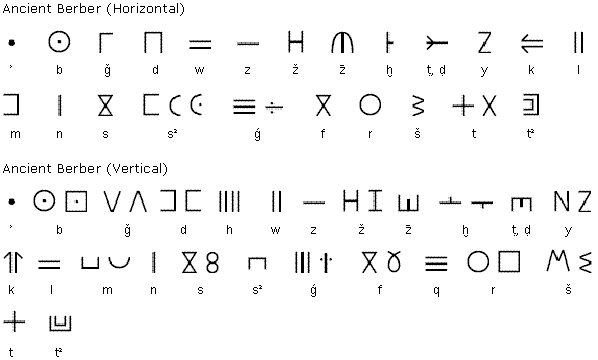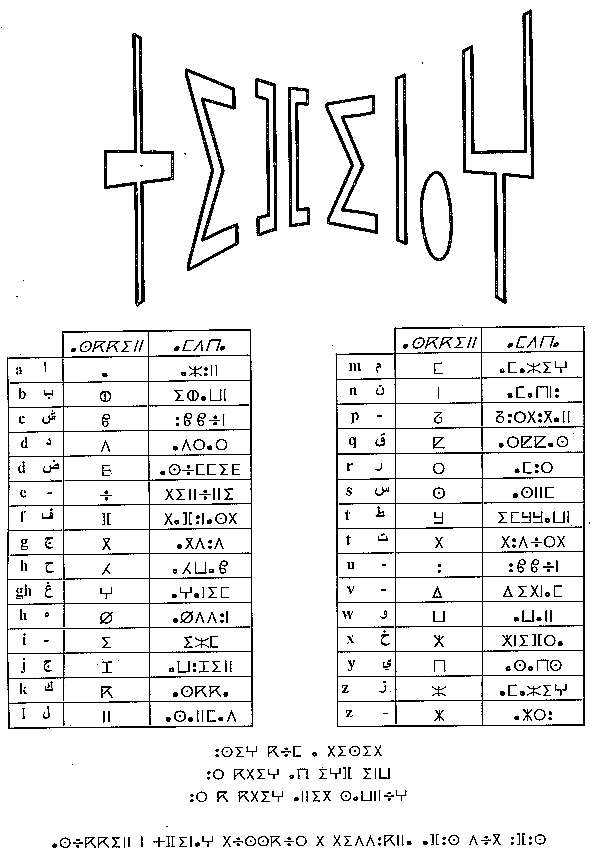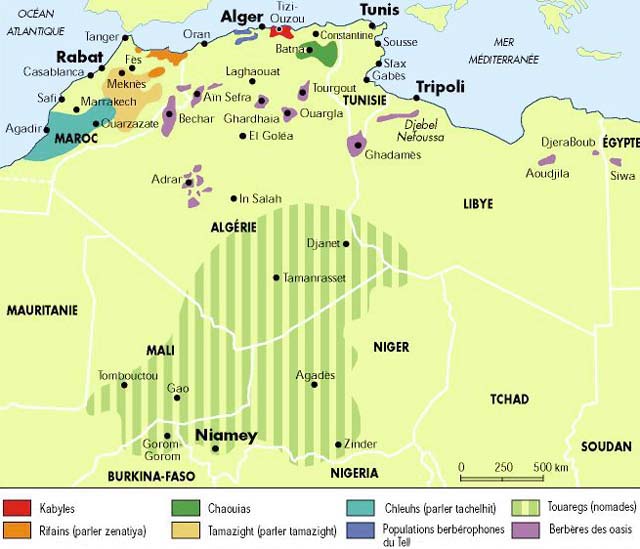
Among the Tuaregs, especially the Tuareg women, the use continued up to our time. There are many regional variations.
The name Tifinagh of the alphabet is said to mean "Phoenician".
A standardized version, sometimes called neo-tifinagh, is in use in primary schools in Morocco since Sept 2003.


Vowels are not written. In order to avoid confusion with the l, the combination nn is written |/, and ln is written ||/.

 |
 |
 |
  |
 |
 |
 |
 |
 |
  |
 |
 |
 |
 |
 |
 |
| ya | yab | yag | yagw | yad | yaḍ | yey | yef | yak | yakw | yah | yaḥ | yaε | yax | yaq | yi |
| a ا | b ب | g گ | gw | d د | ḍ ض | e | f ف | k ك | kw | h ه | ḥ ح | ε ع | x خ | q ق | i ي |
 |
 |
 |
 |
 |
 |
 |
 |
 |
 |
 |
 |
 |
 |
 |
 |
 |
| yaj | yal | yam | yan | yu | yar | yaṛ | yaγ | yas | yaṣ | yac | yat | yaṭ | yaw | yay | yaz | yaẓ |
| j ج | l ل | m م | n ن | u و | r ر | ṛ *) | γ غ | s س | ṣ ص | c ش | t ت | ṭ ط | w و | y ي | z ز | ẓ ژ |
*) The Arabic correspondence given is
ر-with-three-dots-below
 ,
perhaps not in Unicode.
,
perhaps not in Unicode.
This is the alphabet used by the publications of IRCAM. Texts written in it look rather unlike "classical" tifinagh texts because of the lack of those multi-dot symbols. Note the b glyph, different from everybody else's, while the latter has become the h. Here l and f have connected glyphs, and no special care is needed for the nn combination. Vowels are now written.
See The IRCAM Tifinagh alphabet.
| 0 | 1 | 2 | 3 | 4 | 5 | 6 | 7 | 8 | 9 | A | B | C | D | E | F | |
| 2D30 |  |
 |
 |
 |
 |
 |
 |
 |
 |
 |
 |
 |
 |
 |
 |
 |
| 2D40 |  |
 |
 |
 |
 |
 |
 |
 |
 |
 |
 |
 |
 |
 |
 |
 |
| 2D50 |  |
 |
 |
 |
 |
 |
 |
 |
 |
 |
 |
 |
 |
 |
 |
 |
| 2D60 |  |
 |
 |
 |
 |
 |
 |
Unicode names are of the form TIFINAGH LETTER aa xx,
where the aa part is empty or an origin indicator
(here abbreviated: "A." is "AHAGGAR", "AY." is "AYER",
"B." is "BERBER ACADEMY", "TA." is "TAWELLEMET", "T." is "TUAREG")
and the xx part the Berber name of the letter.
The only exception is 2D6F, the TIFINAGH MODIFIER LETTER LABIALIZATION MARK.
| YA | YAB | YABH | YAG | YAGHH | B. YAJ | YAJ | YAD | YADH | YADD | YADDH |
 |
 |
 |
 |
 |
 |
 |
 |
 |
 |
 |
| ⴰ | ⴱ | ⴲ | ⴳ | ⴴ | ⴵ | ⴶ | ⴷ | ⴸ | ⴹ | ⴺ |
| YEY | YAF | YAK | T. YAK | YAKHH | YAH | B. YAH | T. YAH | YAHH | YAA | YAKH |
 |
 |
 |
 |
 |
 |
 |
 |
 |
 |
 |
| ⴻ | ⴼ | ⴽ | ⴾ | ⴿ | ⵀ | ⵁ | ⵂ | ⵃ | ⵄ | ⵅ |
| T. YAKH | YAQ | T. YAQ | YI | YAZH | A. YAZH | T. YAZH | YAL | YAM | YAN | T. YAGN |
 |
 |
 |
 |
 |
 |
 |
 |
 |
 |
 |
| ⵆ | ⵇ | ⵈ | ⵉ | ⵊ | ⵋ | ⵌ | ⵍ | ⵎ | ⵏ | ⵐ |
| T. YANG | YAP | YU | YAR | YARR | YAGH | T. YAGH | AY. YAGH | YAS | YASS | YASH |
 |
 |
 |
 |
 |
 |
 |
 |
 |
 |
 |
| ⵑ | ⵒ | ⵓ | ⵔ | ⵕ | ⵖ | ⵗ | ⵘ | ⵙ | ⵚ | ⵛ |
| YAT | YATH | YACH | YATT | YAV | YAW | YAY | YAZ | TA. YAZ | YAZZ | |
 |
 |
 |
 |
 |
 |
 |
 |
 |
 |
 |
| ⵜ | ⵝ | ⵞ | ⵟ | ⵠ | ⵡ | ⵢ | ⵣ | ⵤ | ⵥ | ⵯ |
Note that this Unicode repertoire is not an alphabet, but a random union of symbols that have been used recently. In some cases the meaning varies regionally. The YAH (2D40) is the Tuareg YAB. The YU (2D53) is the Tuareg YAW. The AYER YAGH (2D58) is the Adrar YAJ.
PetitPrince-Astronome-Tifinaghe.html.

Tamazight is used as a broad name (instead of Berber) and as a more narrow language name in the Middle Atlas. In Morocco: Tarifit (Riffi), Tachelhit (Tashelhiyt), and Tamazight. In Algeria: Kabyle, Tachawit. Tuareg: Tamasheq, Tahaggart Tamahaq, Tayart Tamajeq, and Tawallammat Tamajaq. These four Tuareg dialects are also collectively called Tamasheq.